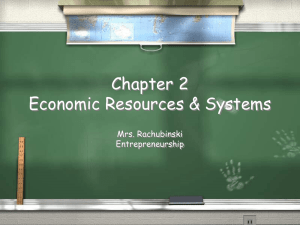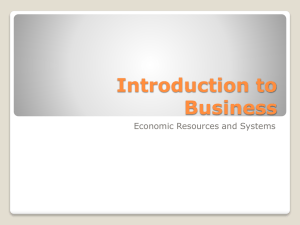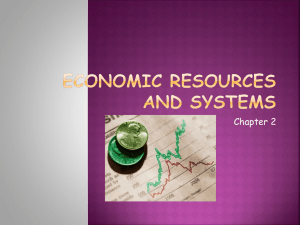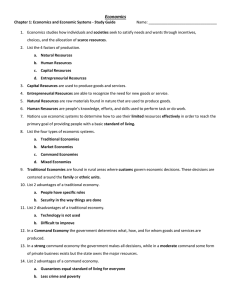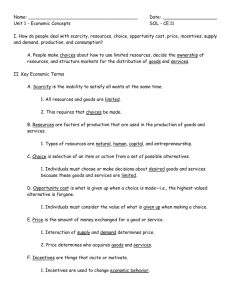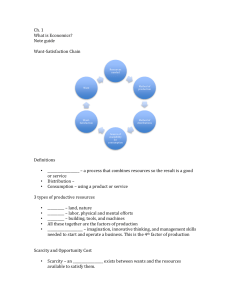Chapter 2 Objectives
advertisement
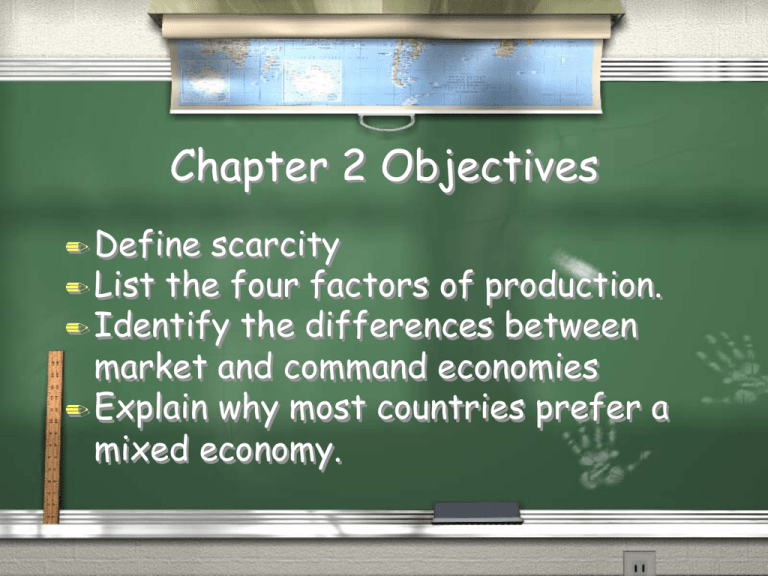
Chapter 2 Objectives ✏ Define scarcity ✏ List the four factors of production. ✏ Identify the differences between market and command economies ✏ Explain why most countries prefer a mixed economy. Chapter 2 Economic Resources and Systems What is Economics? Chapter 2.1 Critical Thinking & Discussion ✏ Did a store ever run out of an item you wanted to buy? ✏ Did a store ever discontinue an item you liked? ✏ What did you do? ✏ Why was the store out of the item? ✏ Scarcity ✏ A shortage of resources. ✏ Example: A community not having enough oil, doctors, or technology to satisfy wants and needs. Factors of Production Factors of Production ✏ Everything that is necessary to produce a society’s goods and services. 4 Factors of Production 1. Natural Resources 2. Labor Resources 3. Capital Resources 4. Entrepreneurial Resources 1. Natural Resources ✏ Raw materials found in nature. ✏ Used to produce goods. ✏ Examples: Trees -> Paper Fish -> harvested for food Natural Resources (continued) ✏ Elements that can be combined to create goods. ✏ Countries depend on their natural resources. 2 Types of Natural Resources ✏ Renewable ✏ Can be reproduced ✏ Ex: wheat, cattle ✏ Nonrenewable ✏ Limited ✏ Ex: coal, iron, oil 2. Labor Resources ✏ Knowledge, efforts, and skills people bring to their work. ✏ Examples: teachers, coal miners, managers, farmers Labor Resources (continued) ✏ Skilled or unskilled ✏ Physical ✏ Labor or intellectual Unions 3. Capital Resources ✏ Things used to produce goods and services. ✏ Examples: Buildings, materials, equipment, delivery trucks, supermarkets, cash registers, etc. 4. Entrepreneurial Resources ✏ Meets the changing wants and needs of people. ✏ Entrepreneurs recognize the need for new goods and services. ✏ Improve resources Chapter 2.2 TYPES OF ECONOMIC SYSTEMS Three Basic Economic Questions ✏ What goods or services should be produced? ✏ How goods or services should be produced? ✏ For whom goods or services should be produced? Economics ✏ How society chooses to use resources: produce and distribute goods and services. ✏ Business Contribution ✏ Inventing resources products that use available Economic System ✏ ‘monitors’ resources ✏ Goal: provide people with a minimum standard of living or quality of life ✏ 2 types of economic systems: ✏ Market Economy ✏ Command Economy Create a large ven diagram in your notes – half of a page in size. Label one side ‘Market Economy’, one side ‘Command Economy’, and Both in the middle. Market Economy ✏ Economic decisions are made in the marketplace Market Economic System ✏ Capitalism ✏ Resources ✏ Own are privately owned your house, land, business, etc. ✏ Government control is minimal ✏ In reference to the US, what does the government control? Record in notes Market Economy (continued) ✏ The Profit Motive ✏ Desire to make more money ✏ Businesses constantly competing ✏ Owners and producers reap most rewards ✏ Fact: CEOs make 500 times avg workers Price, Supply and Demand ✏ ✏ ✏ Price-the amount of money given or asked for when goods or services are bought or sold Supply-is the amount of goods and services that producers will provide at various prices Demand-is the amount or quantity of goods and services that consumers are willing to buy at various prices. Supply and Demand ✏ Refer to p.30 ✏ Choose a product refer back to p. 29 “real world” and using your ipad find out the supply and demand correlation for that particular product over the last 10-15 years. Create a supply and demand chart in your notes. Command Economy ✏ Central authority makes key economic decisions. Command Economy ✏ Government ✏ Airlines owns major resources and steel ✏ Makes key economic decisions ✏ Individuals may own some businesses Mixed Economy ✏ Combination economies ✏ The of market and command government takes care of peoples needs, the marketplace takes care of peoples wants.
